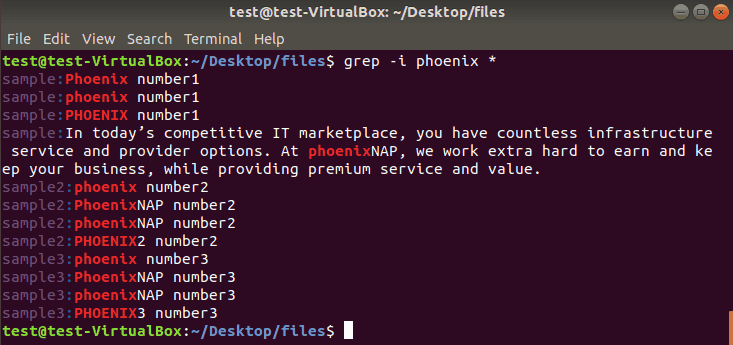


etc/sysconfig/network-scripts/ifcfg-eth0:HOSTNAME=”smatteso-vm1″ This is performed using the -r switch, which I’ll use to search for my user account name in the /etc directory: You can use what’s known as a recursive search to cover entire directories, subdirectories, or the entire file system and get results showing each filename that contains your search value. Grep can do much more than just search the contents of a specific file. Which would show you all the non-matching entries with their associated line numbers:ġ:Apr 2 03:45:07 smatteso-vm1 sshd: Connection closed by 10.1.7.101Ģ:Apr 2 03:46:42 smatteso-vm1 su: pam_unix(su-l:session): session opened for user phxinst1 by (uid=0)ģ:Apr 2 03:46:45 smatteso-vm1 su: pam_unix(su-l:session): session closed for user phxinst1Ĥ:Apr 2 03:46:45 smatteso-vm1 su: pam_unix(su-l:session): session opened for user phxinst1 by (uid=0)ĥ:Apr 2 03:46:48 smatteso-vm1 su: pam_unix(su-l:session): session closed for user phxinst1 7.Search across multiple files Of course you can combine strings such as -v and -n: For instance, to see entries in the /var/log/secure file which do not represent the word “failure” type:Īnd then you would get results like this:Īpr 2 03:46:45 smatteso-vm1 su: pam_unix(su-l:session): session opened for user phxinst1 by (uid=0) There are some scenarios in which you might want to do a reverse search and show results which do NOT match your input. 6.Display all entries which are NOT a match. Note there cannot be a space between “-m” and your maximum count value. I can narrow these down using the -m (maximum count) switch:Īpr 4 06:45:31 smatteso-vm1 sshd: pam_unix(sshd:auth): authentication failure logname= uid=0 euid=0 tty=ssh ruser= rhost= Let’s say I want to only see the first five search results. Grep would then return something like this:ġ601:Apr 4 06:45:29 smatteso-vm1 sshd: pam_unix(sshd:auth): authentication failure logname= uid=0 euid=0 tty=ssh ruser= rhost= user=8boa5lv2rn8pso8ġ612:Apr 4 06:45:31 smatteso-vm1 sshd: pam_unix(sshd:auth): authentication failure logname= uid=0 euid=0 tty=ssh ruser= rhost= user=13hr26mnm8wo4k 5.Return only a specific number of matches It can be helpful to know which line number your search results appear on. Grep -c processor /proc/cpuinfo 4.Display the line numbers of each match For instance, if I want to know how many processors are in my system I could type: You can do some clever things with this switch. This is performed using the -c (count) switch: You may not want to actually see the output of the grep command but have it tell you how many matches your search found. Oracle Linux checklist: What to do after installation This Linux learning path will help you start using the OS like a proītop is a much-improved take on the Linux top command Open-source repository SourceHut to remove all cryptocurrency-related projects

This command permits you to check for multiple words in a file – note the use of the single quotes, the backslash and the pipe command between them:Īpr 2 03:45:07 smatteso-vm1 sshd: Connection closed by 10.1.7.101Īpr 2 03:46:42 smatteso-vm1 su: pam_unix(su-l:session): session opened for user phxinst1 by (uid=0)Īpr 2 03:46:45 smatteso-vm1 su: pam_unix(su-l:session): session closed for user phxinst1Īpr 2 03:46:45 smatteso-vm1 su: pam_unix(su-l:session): session opened for user phxinst1 by (uid=0) Open source: Must-read coverage In the example above this would return the lowercase “failure,” uppercase “FAILURE” or any combination thereof, such as “Failure.”. grep -i) to conduct a case insensitive search. This is an example of what grep might then return:Īpr 4 06:45:29 smatteso-vm1 sshd: pam_unix(sshd:auth): authentication failure logname= uid=0 euid=0 tty=ssh ruser= rhost= user=8boa5lv2rn8pso8Īpr 4 06:45:31 smatteso-vm1 sshd: pam_unix(sshd:auth): authentication failure logname= uid=0 euid=0 tty=ssh ruser= rhost= user=13hr26mnm8wo4kĪdd the -i switch (e.g.

Let’s say I want to inspect the contents of the /var/log/secure log for any instances of a failure. This is really one of the most elementary uses for grep. Here are 10 examples to help sharpen your skills. The options and patterns you can use with grep are varied and diverse. I’ll focus on regular grep for the purpose of this article, which is intended as a beginning tutorial for this handy and reliable command. The latter two have different methods for working with characters and search strings. There are multiple versions of grep plain regular grep, egrep (extended grep) and fgrep (fixed prep).
#GREP COMMAND IN LINUX WINDOWS#
Windows search is not without certain charms, but when I need to find files or their contents, or search for specific system information, the grep command in Linux never ceases to amaze me through its power and versatility.


 0 kommentar(er)
0 kommentar(er)
